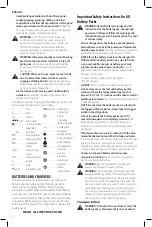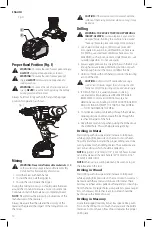
English
3
work to be performed.
Use of the power tool for
operations different from those intended could result
in a hazardous situation.
h )
Keep handles and grasping surfaces dry, clean
and free from oil and grease.
Slippery handles and
grasping surfaces do not allow for safe handling and
control of the tool in unexpected situations.
5) Battery Tool Use and Care
a )
Recharge only with the charger specified by the
manufacturer.
A charger that is suitable for one type
of battery pack may create a risk of fire when used
with another battery pack.
b )
Use power tools only with specifically designated
battery packs.
Use of any other battery packs may
create a risk of injury and fire.
c )
When battery pack is not in use, keep it away
from other metal objects, like paper clips, coins,
keys, nails, screws or other small metal objects,
that can make a connection from one terminal to
another.
Shorting the battery terminals together may
cause burns or a fire.
d )
Under abusive conditions, liquid may be ejected
from the battery; avoid contact. If contact
accidentally occurs, flush with water. If liquid
contacts eyes, additionally seek medical help.
Liquid ejected from the battery may cause irritation
or burns.
e )
Do not use a battery pack or tool that is
damaged or modified.
Damaged or modified
batteries may exhibit unpredictable behavior resulting
in fire, explosion or risk of injury.
f )
Do not expose a battery pack or tool to
fire or excessive temperature.
Exposure to
fire or temperature above 265 °F (130 °C) may
cause explosion.
g )
Follow all charging instructions and do not
charge the battery pack or tool outside the
temperature range specified in the instructions.
Charging improperly or at temperatures outside the
specified range may damage the battery and increase
the risk of fire.
6) Service
a )
Have your power tool serviced by a qualified
repair person using only identical replacement
parts.
This will ensure that the safety of the power
tool is maintained.
b )
Never service damaged battery packs.
Service
of battery packs should only be performed by the
manufacturer or authorized service providers.
Drill Safety Warnings
•
Always use the side handle.
Loss of control can cause
personal injury.
•
Hold power tool by insulated gripping surfaces,
when performing an operation where the cutting
accessory may contact hidden wiring.
Cutting
accessory contacting a “live” wire may make exposed
metal parts of the power tool “live” and could give the
operator an electric shock.
Mixer Safety Instructions
•
Hold the tool with both hands at the intended
handles.
Loss of control can cause personal injury.
•
Ensure sufficient ventilation when mixing
flammable materials to avoid a hazardous
atmosphere.
Developing vapour may be inhaled or be
ignited by the sparks the power tool produces.
•
Do not mix food.
Power tools and their accessories are
not designed for processing food.
•
Ensure that the mixing container is placed in a firm
and secure position.
A container that is not properly
secured may move unexpectedly.
•
Ensure that no liquid splashes against the housing
of the power tool.
Liquid that has penetrated the power
tool can cause damage and lead to electric shock.
•
Follow the instructions and warnings for the
material to be mixed.
Material to be mixed may
be harmful.
•
If the power tool falls into the material to be mixed,
remove the battery immediately and have the power
tool checked by a qualified repair person.
•
Do not reach into the mixing container with your
hands or insert any other objects into it while
mixing.
Contact with the mixer basket may lead to
serious personal injury.
•
Start up and run down the tool in the mixing
container only.
The mixer basket may bend or spin in an
uncontrolled manner.
•
Never mix flammable materials.
Refer to the material
package label and Material Safety Data Sheet for
flammability information.
Additional Safety Information
WARNING: ALWAYS
use safety glasses. Everyday
eyeglasses are NOT safety glasses. Also use face or
dust mask if cutting operation is dusty. ALWAYS WEAR
CERTIFIED SAFETY EQUIPMENT:
• ANSI Z87.1 eye protection (CAN/CSA Z94.3),
• ANSI S12.6 (S3.19) hearing protection,
• NIOSH/OSHA/MSHA respiratory protection.
WARNING:
Some dust created by power sanding,
sawing, grinding, drilling, and other construction
activities contains chemicals known to the State
of California to cause cancer, birth defects or
other reproductive harm. Some examples of these
chemicals are:
• lead from lead-based paints,
• crystalline silica from bricks and cement and other
masonry products, and
• arsenic and chromium from chemically-
treated lumber.
Your risk from these exposures varies, depending on how
often you do this type of work. To reduce your exposure to
these chemicals: work in a well ventilated area, and work with
approved safety equipment, such as those dust masks that are
specially designed to filter out microscopic particles.






































